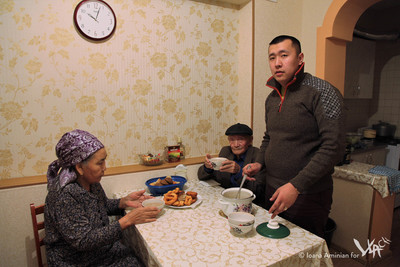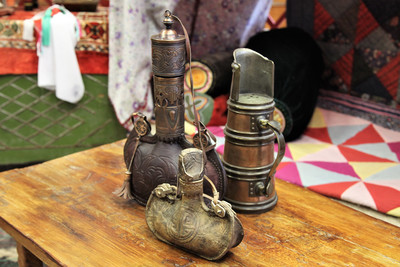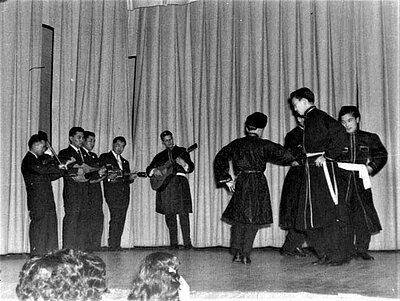
Glottocode: kalm1244, ISO 639-2: xal
OIRAT-KALMYK (KALM. ХАЛЬМГ КЕЛН)
Kalmyk or Kalmyk-Oirat is a branch of the Oirat language and belongs to the Mongolian group of Altaic languages. It is spoken by Kalmyk people in the Kalmykia Republic of the Russian Federation. The language is definitely endangered: according to the Russian census of 2010, there are 80,500 speakers of an ethnic population consisting of 183,000 people.
In the first half of the XVII century, Central Asian Oirat nomadic tribes of Torgud and Dörvüd origin began their migration towards Europe, occupying a vast tract of steppe around the lower Volga region before establishing The Kalmyk (Torgut) Khanate (1630 – 1771). In 1771, the majority of the Kalmyk community migrated back to Dzhungaria, the homeland of Oirat Mongolian tribes. Those Kalmyk people who remained on the Caspian steppe were integrated into the Russian Empire and today live mainly in the Republic of Kalmykia, Astrakhan and Volgograd regions of the Russian Federation. Small Kalmyk diasporas can be found in USA, France, Czech Republic.
The Republic of Kalmykia is located in the southern European region of the Russian Federation, surrounded by Rostov, Volgograd, Astrakhan, Dagestan and the Stavropol region(s).
Settlements represented in our collection
read more...
read more...
Since XVII century, Oirat-Kalmyk language has had its own alphabet of todo bichig (clear script), an improved variant of Mongolian script, which was designed by Buddhist monk and enlightener Zaya Pandita Ogtorguin Dalai. In 1924 the use of todo bichig was forbidden and a new Cyrillic alphabet was introduced.
In 1994, the Kalmyk and Russian gained the status of official languages of the Republic of Kalmykia (1). Kalmyk language and literature are included as separate subjects in the education system of Kalmykia. Kalmyk State University offers Bachelor and Master programs in Kalmyk philology. In addition, there are a (small) number of periodicals which publish materials written in Kalmyk. Two local television companies also produce news and other programs in the language.
According to a census conducted in 2010, the Kalmyk population within the Russian Federation was 183,372. Of those, 162,740 live in Kalmykia, 6,624 in Astrakhan and 1,576 in the regions of Volgograd (2). 80,547 people indicated that they were able to communicate in the Kalmyk language (2). However, this figure remains unreliable as there has not yet been any specific linguistic or sociological research into the Kalmyk population of these regions.
The Kalmyk language is divided into three main dialects: Torgut, Derbet, Buzav. At present, the specific dialectal features of these are mainly preserved in the speech of the older generation of Kalmyks. Middle-aged people communicate mostly in Russian but have a passive knowledge of Kalmyk. The majority of young Kalmyks have very poor awareness of their native language. According to UNESCO Atlas of the World’s Languages in Danger, Kalmyk is a definitely endangered language (3).
Sources:
1. The Constitution of Republic of Kalmykia
2. The Russian Federation Census of 2010.
3. UNESCO Atlas of the World's Languages in Danger.
Basic scientific bibliography:
BITKEEV, PETR TS., DORAEVA, ROZA P., PAVLOV, DORDZHI A., PIURBEEV, GRIGORY TS. AND OTHERS (1983): Грамматика калмыцкого языка. Фонетика и морфология [The grammar of Kalmyk language. Phonetics and Morthology], Kalmyk publishing house, Elista, 355 p.
KICHIKOV ANATOLY SH. (1963): Дербетский говор. Фонетико-морфологическое исследование [Derbet dialect. phonetic-morphological research], Elista, Kalmyk publishing house, 87 p.
PAVLOV, DORDZHI A. (1963): Современный калмыцкий язык. Фонетика и графика [Modern Kalmyk language. Phonetics and the alphabet], Elista, Kalmyk publishing house, 240 p.
PIURBEEV, GRIGORY TS. (2010): Грамматика калмыцкого языка. Синтаксис [The grammar of Kalmyk language. Syntax], Kalmyk Institute of Human Studies of Russian Academy of Sciences, Elista, 299 p.
UBUSHAEV, NIKOLAY N. (1979): Фонетика торгутского говора калмыцкого языка [Phonetics of the Torgut dialect of Kalmyk language], Elista, Kalmyk publishing house, 196 p.
Chingis Azydov, 2020










